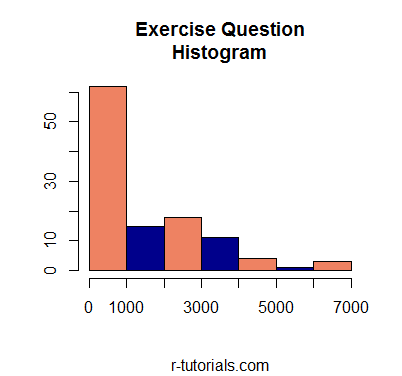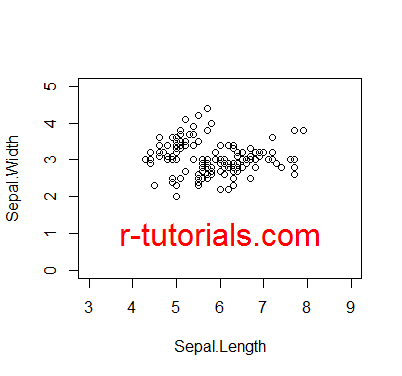R Exercises for Beginners – 1-10
Practicing is a crucial part of learning a new language. Statistical languages like R are no exception of that rule. Many of my students think the same and would love to see more exercises. Therefore, I decided to write an R exercise sheet for beginners and blog it over here. These R exercises are an add-on to the already existing exercise videos available in each and every R-Tutorial product.
On this sheet you will find 10 R exercises corresponding to the material taught in R Basics and R Level 1. The exercise solutions can be found here in an extra blog post.
I will first write down the exercise question and below the question you can see how the console output should look like. The corresponding code is to be found on the solutions page.
Exercises
1a. Get the length of the “lynx” dataset
[1] 114
1b. Create a vector of ordered “lynx” index numbers (hint: order, increasing)
[1] 69 22 70 71 23 68 99 98 12 78 100 21 79 13 72 59 24 32 60 101 41 42 49 [24] 1 14 40 58 2 88 51 33 30 31 73 89 80 67 102 15 20 61 50 109 11 108 25 [47] 43 3 77 110 97 39 48 34 62 57 81 52 90 4 29 111 26 103 74 82 91 56 5 [70] 107 112 53 44 35 54 19 87 63 38 27 55 16 104 66 28 10 113 17 92 36 64 6 [93] 37 106 95 94 45 114 18 83 76 105 96 86 93 7 75 47 65 9 8 85 46 84
1c. Get 2 vectors (index positions and absolute values) with all “lynx” observations smaller than 500 (hint: which, subset)
[1] 1 2 12 13 14 15 20 21 22 23 24 30 31 32 33 40 41 42 49 50 51 58 59 [24] 60 61 67 68 69 70 71 72 73 78 79 80 88 89 98 99 100 101 102 109
and
[1] 269 321 98 184 279 409 409 151 45 68 213 361 377 225 360 299 236 245 255 473 358 299 201 [24] 229 469 389 73 39 49 59 188 377 105 153 387 345 382 81 80 108 229 399 485
length(lynx)
order(lynx)
which(lynx < 500)
subset(lynx, lynx < 500)
2a. Get a Histogram of the “lynx” dataset
2b. Adjust the bin size to 7 bins
2c. Remove the labs and change the bins to 2 alternating colors
2d. Add a subtitle and divide the main title in 2 lines

hist(lynx, col=c("salmon2", "darkblue"), breaks=7,
sub="r-tutorials.com", xlab="", ylab="",
main="Exercise Question\nHistogram")Hint: use \n to get text to next level
3a. Extract Sepal.Length from the “iris” dataset and call the resulting vector mysepal
3b. Get the summation, mean, median, max and min of mysepal
[1] 876.5 [1] 5.843333 [1] 5.8 [1] 4.3 [1] 7.9
3c. Get the summary of mysepal and compare the results with 3b
Min. 1st Qu. Median Mean 3rd Qu. Max. 4.300 5.100 5.800 5.843 6.400 7.900
mysepal = iris$Sepal.Length
sum(mysepal);
mean(mysepal);
median(mysepal);
min(mysepal);
max(mysepal)
summary(mysepal)
4a. Install and load library “dplyr”
4b. Call help for function arrange of “dplyr”
4c. Deinstall “dplyr”
install.packages("dplyr")
library(dplyr)
?arrange
remove.packages("dplyr") 5. Data for this exercise:
x = c(3,6,9)
5a. Repeat x 4 times, but there should be an extra 1 at the end and beginning
[1] 1 3 6 9 3 6 9 3 6 9 3 6 9 1
5b. Call the vector of 5a myvec and extract the 5th value (hint: dplyr, nth)
[1] 3
myvec = c(1, rep(x, times=4), 1)
library(dplyr)
nth(myvec, 5)
6a. Get a subset of “mtcars” with transmission type: manual, and call it mysubset
mpg cyl disp hp drat wt qsec vs am gear carb
Mazda RX4 21.0 6 160.0 110 3.90 2.620 16.46 0 1 4 4
Mazda RX4 Wag 21.0 6 160.0 110 3.90 2.875 17.02 0 1 4 4
Datsun 710 22.8 4 108.0 93 3.85 2.320 18.61 1 1 4 1
Fiat 128 32.4 4 78.7 66 4.08 2.200 19.47 1 1 4 1
Honda Civic 30.4 4 75.7 52 4.93 1.615 18.52 1 1 4 2
Toyota Corolla 33.9 4 71.1 65 4.22 1.835 19.90 1 1 4 1
Fiat X1-9 27.3 4 79.0 66 4.08 1.935 18.90 1 1 4 1
Porsche 914-2 26.0 4 120.3 91 4.43 2.140 16.70 0 1 5 2
Lotus Europa 30.4 4 95.1 113 3.77 1.513 16.90 1 1 5 2
Ford Pantera L 15.8 8 351.0 264 4.22 3.170 14.50 0 1 5 4
Ferrari Dino 19.7 6 145.0 175 3.62 2.770 15.50 0 1 5 6
Maserati Bora 15.0 8 301.0 335 3.54 3.570 14.60 0 1 5 8
Volvo 142E 21.4 4 121.0 109 4.11 2.780 18.60 1 1 4 2
6b. Extract the first 2 variables of the first 2 observations of mysubset
mpg cyl
Mazda RX4 21 6
Mazda RX4 Wag 21 6
mysubset = subset(mtcars, am == 1)
mysubset[c(1,2), c(1,2)]
7a. Get the first 9 observations of “mtcars”
mpg cyl disp hp drat wt qsec vs am gear carb
Mazda RX4 21.0 6 160.0 110 3.90 2.620 16.46 0 1 4 4
Mazda RX4 Wag 21.0 6 160.0 110 3.90 2.875 17.02 0 1 4 4
Datsun 710 22.8 4 108.0 93 3.85 2.320 18.61 1 1 4 1
Hornet 4 Drive 21.4 6 258.0 110 3.08 3.215 19.44 1 0 3 1
Hornet Sportabout 18.7 8 360.0 175 3.15 3.440 17.02 0 0 3 2
Valiant 18.1 6 225.0 105 2.76 3.460 20.22 1 0 3 1
Duster 360 14.3 8 360.0 245 3.21 3.570 15.84 0 0 3 4
Merc 240D 24.4 4 146.7 62 3.69 3.190 20.00 1 0 4 2
Merc 230 22.8 4 140.8 95 3.92 3.150 22.90 1 0 4 2
7b. Get the “mtcars” dataset ordered according to the increasing amount of “carb”
hint for 7b: library dplyr, arrange
head(mtcars, 9)
library(dplyr)
arrange(mtcars, carb)
8a. Get the means of the first 2 columns in the “iris” dataset by Species
iris$Species: setosa
Sepal.Length Sepal.Width
5.006 3.428
--------------------------
iris$Species: versicolor
Sepal.Length Sepal.Width
5.936 2.770
--------------------------
iris$Species: virginica
Sepal.Length Sepal.Width
6.588 2.974
8b. Create vector x which is the alternation of 1 and 2, 75 times, check the length
[1] 1 2 1 2 1 2 1 2 1 2 1 2 1 2 1 2 1 2 1 2 1 2 1 2 1 2 1 2 1 2 1 2 1 2 1 2 1 2 1 2 1 2 1 2 1 2 [47] 1 2 1 2 1 2 1 2 1 2 1 2 1 2 1 2 1 2 1 2 1 2 1 2 1 2 1 2 1 2 1 2 1 2 1 2 1 2 1 2 1 2 1 2 1 2 [93] 1 2 1 2 1 2 1 2 1 2 1 2 1 2 1 2 1 2 1 2 1 2 1 2 1 2 1 2 1 2 1 2 1 2 1 2 1 2 1 2 1 2 1 2 1 2 [139] 1 2 1 2 1 2 1 2 1 2 1 2
8c. Attach x to iris as dataframe “irisx”, check the head
Sepal.Length Sepal.Width Petal.Length Petal.Width Species x 1 5.1 3.5 1.4 0.2 setosa 1 2 4.9 3.0 1.4 0.2 setosa 2 3 4.7 3.2 1.3 0.2 setosa 1 4 4.6 3.1 1.5 0.2 setosa 2 5 5.0 3.6 1.4 0.2 setosa 1 6 5.4 3.9 1.7 0.4 setosa 2
8d. Get the colsums of columns 1,3,4 in the “irisx” dataset by the new x variable
irisx$x: 1
Sepal.Length Petal.Length Petal.Width
438.0 283.2 91.4
---------------------------------------
irisx$x: 2
Sepal.Length Petal.Length Petal.Width
438.5 280.5 88.5
by(iris[,1:2], iris$Species, colMeans)
x = rep(1:2, times=75); length(x)
irisx = data.frame(iris, x); head(irisx)
by(irisx[,c(1,3,4)], irisx$x, colSums)
9a. How many observations in “lynx” are smaller than 500?
[1] 43
9b. How many observations in “iris” have a Sepal.Length greater or equal 5?
[1] 128
sum(lynx < 500)
sum(iris$Sepal.Length >= 5)
10a. Plot a simple xy plot with “iris” Sepal.Length vs. Sepal.Width
10b. Enlarge the scale limits: y from 0 – 5, x from 3 – 9
10c. Add a text of your choosing, in red, at the lower part of the plot

attach(iris)
plot(Sepal.Length, Sepal.Width)
plot(Sepal.Length, Sepal.Width, ylim=c(0,5), xlim=c(3,9))
text(6,1, "r-tutorials.com", col="red", cex=2, lwd=2) 


